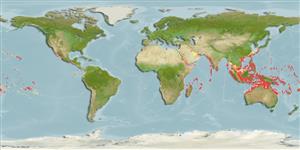>
Gobiiformes (Gobies) >
Gobiidae (Gobies) > Gobiinae
Etymology: Priolepis: Greek, prio = to saw + Greek,lepis = scale (Ref. 45335); cincta: Name from Latin cinctum, a girdle or belt, presumably referring to the banded color pattern; treated as a noun in apposition by Winterbotton & Burridge, 1993:2063 (Ref. 10753).
More on author: Regan.
Issue
Specific name to be examined, treated as a noun in apposition in Ref. 10753, but CofF treat the name as an adjective.
Environment: milieu / climate zone / depth range / distribution range
Ecologia
marinhas; estuarina associadas(os) a recifes; não migratória; intervalo de profundidade 1 - 70 m (Ref. 2334), usually 1 - 30 m (Ref. 9002). Tropical; 32°N - 24°S
Indo-West Pacific: Red Sea, Persian Gulf and east coast of Africa to islands of Micronesia, Fiji and Tonga; Japan to Coral Sea.
Tamanho / Peso / Idade
Maturity: Lm ? range ? - ? cm
Max length : 7.0 cm FL macho/indeterminado; (Ref. 5525)
Descrição breve
Chaves de identificação | Morfologia | Morfometria
Espinhos dorsais (total) : 7 - 8; Raios dorsais moles (total) : 11; Espinhos anais: 1; Raios anais moles: 9. Characterized by having alternating dark-edged brown and narrower white bars on head and body; dorsal and caudal fins with brown spotting; basal part of dorsal fins with dark spots/bands; longitudinal scale series 27-31; ctenoid scales on body except cycloid on abdomen, prepectoral and prepelvic areas; upper opercle with a patch of cycloid scales; cheek without scales; depth of body 3.8-4.6 in SL (Ref. 90102).
Hides in caves and crevices (Ref. 9710), also among corals or rock (Ref. 37816). Monogamous (Ref. 52884).
Life cycle and mating behavior
Maturidade | Reprodução | Desova | Ovos | Fecundidade | Larvas
Benthic spawner (Ref. 31409). Bi-directional sex change was proposed for this species (Ref. 103751). Monogamous mating is observed as both obligate and social (Ref. 52884).
Randall, J.E., G.R. Allen and R.C. Steene, 1990. Fishes of the Great Barrier Reef and Coral Sea. University of Hawaii Press, Honolulu, Hawaii. 506 p. (Ref. 2334)
Categoria na Lista Vermelha da IUCN (Ref. 130435: Version 2024-1)
Ameaça para o homem
Harmless
Utilização humana
Pescarias: espécies comerciais; Aquário: Espécies comerciais
Ferramentas
Relatórios especiais
Descarregue XML
Fontes da internet
Estimates based on models
Preferred temperature (Ref.
123201): 24.8 - 29, mean 27.7 °C (based on 1094 cells).
Phylogenetic diversity index (Ref.
82804): PD
50 = 0.5000 [Uniqueness, from 0.5 = low to 2.0 = high].
Bayesian length-weight: a=0.00851 (0.00502 - 0.01443), b=3.04 (2.90 - 3.18), in cm total length, based on LWR estimates for this species & (Sub)family-body (Ref.
93245).
Nível Trófico (Ref.
69278): 3.3 ±0.3 se; based on size and trophs of closest relatives
Resiliência (Ref.
120179): Elevada, tempo mínimo de duplicação da população menor que 15 meses (Preliminary K or Fecundity.).
Fishing Vulnerability (Ref.
59153): Low vulnerability (10 of 100).
Nutrients (Ref.
124155): Calcium = 141 [73, 310] mg/100g; Iron = 0.908 [0.442, 1.714] mg/100g; Protein = 18.6 [16.6, 20.2] %; Omega3 = 0.186 [0.081, 0.349] g/100g; Selenium = 24.8 [11.6, 64.8] μg/100g; VitaminA = 131 [35, 444] μg/100g; Zinc = 2.53 [1.67, 3.75] mg/100g (wet weight);
